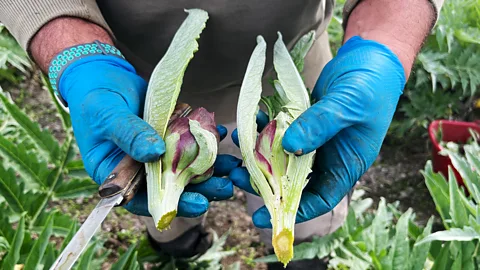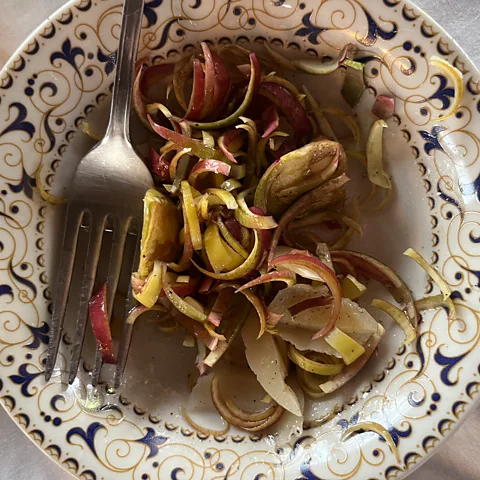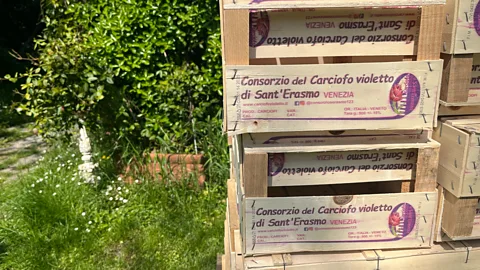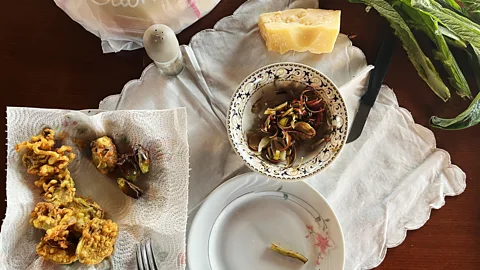The artichoke so prized that people sell fakes
 Catherine Bennett
Catherine BennettFor just two weeks each spring, a rare violet artichoke is harvested by hand on Venice's northern islands – and locals go to great lengths to keep it authentic.
The water glitters in the sunlight as Venetian farmer Guia Camerino steers her boat past the briccole, the wooden piles that mark invisible – to non-Venetians – lanes through the lagoon. Just a few kilometres north of Venice's warren of tourist-packed streets are the islands of Sant'Erasmo and Le Vignole, known as "the vegetable garden of Venice" for their lush, fertile ground – and for a rare flower that grows for only 10 days a year.
Camerino is one of just four farmers on the island of Le Vignole, and she specialises in the carciofo violetto di Sant'Erasmo, a Venetian type of artichoke plant that produces a local delicacy known as a castraùra. The castraùre are the plant's first buds: small, tight and conical artichokes that are "castrated" off the plant – giving them their name – in order to allow the botoli, larger buds (and the kind you'd probably find on your plate the rest of the year), to grow in their place.
Spring is a busy time of year for Camerino as the violet artichokes come into bloom and must be harvested during a short window of about two weeks, with each plant only producing one castraùra a year. The tiny artichokes, half the size of a human palm, are highly prized, both for their rarity and their unique, saline taste.
"It's hard to describe the taste if you've never had it before," she explains, as we walk through her artichoke fields, the belltowers of Venice visible on the horizon. "It's initially bitter but transforms into sweetness in the mouth. It's very versatile and easy to eat – not like a Roman artichoke that you have to peel and prepare laboriously. The castraùre are so tender that you can eat them raw."
 Catherine Bennett
Catherine BennettThe castraùre's rarity means that for years Venetian farmers have had to deal with counterfeit versions coming from elsewhere in Italy. The violet artichoke doesn't just grow in the Veneto – this species of plant is also grown in Tuscany, Sardinia and Sicily. But any Venetian will tell you that a true Sant'Erasmo artichoke tastes nothing like its terraferma counterparts. That's because the islands are positioned at the lagoon's opening to the Adriatic, which makes the soil distinctively salty – a salinity that is tempered by rainwater. There's even a festival dedicated to the artichoke (usually on the second Sunday in May) when people travel from all over the lagoon to Sant'Erasmo to eat artichoke dishes, drink artichoke-based spritzes or digestifs and buy entire pallets of the vegetable to take home before the season ends.
World's Table
BBC.com's World's Table "smashes the kitchen ceiling" by changing the way the world thinks about food, through the past, present and future.
It's not easy to coax the flower out of the plant. Everything is done by hand, with no pesticides, and in Venice there's the ever-present danger of an acqua alta (seasonal flooding) that could drown the fields. An artichoke is a perennial plant that has to be cut back every summer in order to grow imperceptibly during the winter months. Now climate change is causing the season to arrive earlier and earlier.
"It's very worrying," says Camerino. "The plant needs nine months to slowly grow. Traditionally, the castraùre were harvested on 25 April, Saint Mark's Day. But we harvested our first castraùra at the beginning of April this year. It's getting hotter earlier and earlier, and the plants won't have time to grow. Eventually, the castraùre could disappear."
Because they're so delicate, the castraùre don't get exported far out of the lagoon and are usually harvested, sold and eaten in the same day. Camerino sells directly to restaurants in Venice that "understand the quality" of the product. The problem, she says, is that many restaurants in Venice have stopped buying real castraùre "because they're expensive and non-local customers can't tell the difference. So they use normal artichokes but pretend they're castraùre so they can hike up the prices."
 Catherine Bennett
Catherine BennettHow to try castraùre
• Plan a trip to Venice around mid-April to hit the height of the castraùre season.
• Always ring ahead to see if restaurants are serving them, since it's so dependent on the harvest.
• If you want to try preparing them at home, make sure you only buy artichokes with the consorzio's label – and don't be afraid to grill the seller about where they come from.
• If you miss the season, don't worry; you can buy a jar of violet artichokes preserved in oil from Finotello's farm on Sant'Erasmo.
• You can also get them in liquid form: the amaro digestif Venesian is made from Sant'Erasmo artichokes. Pick up a bottle to take home at the delicatessen Maramao, which sells local products from its canalside shop in the Cannaregio district.
Al Covino, a Venice restaurant that focuses on local produce and traditional ingredients recognised by Italy's Slow Food presidium, makes a point of serving the castraùre when they come into season. It's a cosy space with pistachio-green roof beams, hanging plants and only 15 covers, hidden on a small street in the city's Castello neighbourhood and run by husband-and-wife team Claudio De Lauzieres and Claudia Torcellan. De Lauzieres, a Neopolitan who has been living in Venice for 12 years, rhapsodises about the local ingredients with a boyish enthusiasm: "Neapolitan cuisine is much more well-known than Venetian cuisine, but the lagoon offers so many different environments and unique tastes. The castraùre symbolise the richness of the land here."
He prepares three castraùre dishes: a silky, gently sautéed version that doesn't just melt on the tongue but entirely disappears, leaving a subtly sweet aftertaste; tagliolini in a velvety artichoke sauce; and raw shavings of the vegetable in a salad with oil, parmesan and a hint of lemon zest. He watches my face as I take a bite of the salad and grins at my expression of surprise at the tiny bud's powerful taste. Its flavour instantly takes me back to Camerino's boat and the smell of the salty lagoon air whipping past my face.
On Sant'Erasmo, local farmer Carlo Finotello has been working for years to crack down on the falsely labelled castraùre that appear in markets and shops across the lagoon. He runs the farm I Sapori di Sant'Erasmo with his brother Claudio and is also the president of the Consorzio del Carciofo Violetto di Sant'Erasmo, a consortium created in 2004 to promote the local violet artichoke. Its label is a mark of quality and authenticity.
"Some vegetable sellers take the consorzio label and stick it on other crates of normal artichokes," Finotello explained. "Or they will buy some castraùre but then mix them in with normal artichokes so they're still making a bit extra."
 Catherine Bennett
Catherine BennettWhen the consortium receives a tip-off about producers passing off Tuscan artichokes as the Sant'Erasmo version, Finotello contacts them directly to ask them to desist – but the consortium isn't a policeman, he says, and they have no power to issue fines, nor the time or money to take them to court. He says that it's vital to only buy castraùre from a local producer, and to always make sure that they have the consortium's label, in order to protect the centuries-old tradition of growing them.
I visit Finotello at his farm to see him harvest the castraùre. It's a muggy day with a hot, salty breeze, and the earth is springy after days of rain. The artichoke plants are slowly opening up in the sun. Finotello shows me how to cut a castraùra gently off the stalk with the traditional curved knife, which he holsters in the pocket of his overalls between rows. The plants used to be fertilised with scoasse (garbage in Venetian dialect), a mix of fish bones and old crab shells. "We can't do that anymore because there's too much plastic in the food system," Finotello tells me, shrugging. "We'd just be feeding the plants plastic."
When he finishes harvesting the small field, he counts how many castraùre he picked: 105. He then dumps the basket in the back of his trailer and looks at me, grinning. "Now you need to eat some."
At the farmhouse, his mother, Mirella Bubacco, is holding court in a kitchen busy with the detritus of the recent Italian Easter celebration: chocolate eggs and endless cups of espresso next to slices of colomba, a type of Italian Easter cake. Mirella is warm, businesslike – and very chatty.
"Don't ever eat it as an antipasto!" she warns me, a paring knife in one hand. "The taste lingers in your mouth, and it'll alter the taste of your first course." She insists that it is best eaten in the very simple Venetian style: uncooked, julienned, with a ribbon of light-tasting olive oil, a bit of salt and shavings of Grana Padano. "The earth here on Sant'Erasmo is all the condiment you need!"
--
If you liked this story, sign up for The Essential List newsletter – a handpicked selection of features, videos and can't-miss news, delivered to your inbox twice a week.
